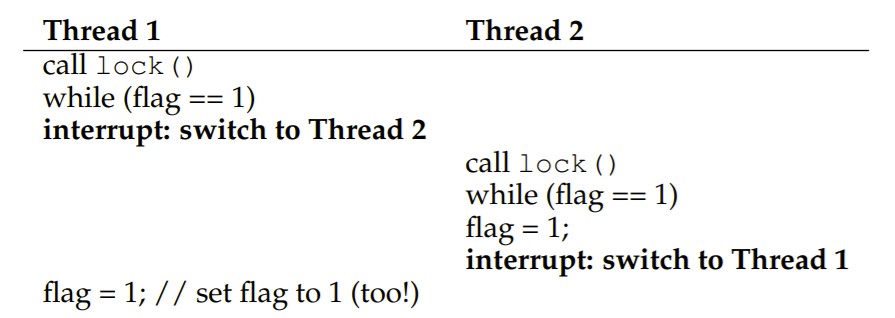Concurency
4个重要概念:
- A critical section is a piece of code that accesses a shared resource, usually a variable or data structure.
- A race condition (or data race [NM92]) arises if multiple threads of execution enter the critical section at roughly the same time; both attempt to update the shared data structure, leading to a surprising (and perhaps undesirable) outcome.
- An indeterminate program consists of one or more race conditions; the output of the program varies from run to run, depending on which threads ran when. The outcome is thus not deterministic, something we usually expect from computer systems.
- To avoid these problems, threads should use some kind of mutual exclusion primitives; doing so guarantees that only a single thread ever enters a critical section, thus avoiding races, and resulting in deterministic program outputs.
How to build a Lock
attempt 1: 使用系统中断调用(对于single-processor system是可行的)
优点: 简单
缺点: 无法在multiprocessors使用, 某个线程可能会恶意占用critical section不退出, 滥用系统中断调用, 效率低……
void lock() {
DisableInterrupts();
}
void unlock() {
EnableInterrupts();
}
For these reasons, turning off interrupts is only used in limited contexts as a mutual-exclusion primitive.
attempt 2: 使用单标志位(错误见下图)
单标志不仅是错误的,同时性能上也很差,存在spin_wait。

typedef struct __lock_t { int flag; } lock_t;
void init(lock_t* mutex) {
mutex->flag = 0;
}
void lock(lock_t* mutex) {
while (mutex->flag == 1) ;
mutex->flag = 1;
}
void unlock(lock_t* mutex) {
mutex->flag = 0;
}
attempt 3: 利用硬件实现的Test-And-Set机制。
- 1、当critical section未被抢占时,当前线程call TestAndSet得到返回值为0,可以获得该锁。
- 2、当critical section已经被另一线程抢占时,当前线程想要call TestAndSet时会将
*old_ptr = 1,但是由于已经被抢占了,返回的值为1,此时spin-wait(while循环调用,但是返回值一直为1),直到另一线程unlock。
效果:correctness, fairness, performance?
正确的。
由于是抢占式的,可能存在线程一直spin-wait。
这依赖于single CPU/multiple CPUs,single cpu情况下,critical section被抢占情况下,任何其它线程都需要spin一次。
// c伪代码实现硬件过程
int TestAndSet(int *old_ptr, int new) {
int old = *old_ptr;
*old_ptr = new;
return old;
}
typedef struct __lock_t { int flag; } lock_t;
void lock(lock_t* mutex) {
while (TestAndSet(&lock_t->flag, 1) == 1) ;
}
attemp4:Compare-And-Swap c伪代码如下,机制与Test-And-Set相似。
int CompareAndSwap(int *ptr, int expected, int new) {
int original = *ptr;
if (original == expected) *ptr = new;
return original;
}
void lock(lock_t* mutex) {
while (CompareAndSwap(&lock_t->flag, 0, 1) == 1) ;
}
How to avoid spining
假设thread0获取了锁,那么其余想要访问critical section的线程会一直spin直到消耗完time slice,效率低。
attempt 1: 利用系统调用yield释放CPU资源
考虑RR scheduler,尽管其余线程被调度时都会yield,每次切换线程的开销也非常大。
void lock() {
while (TestAndSet(&flag, 1) == 1)
yield();
}
attempt 2:queue、TestAndSet、yield and wakeup